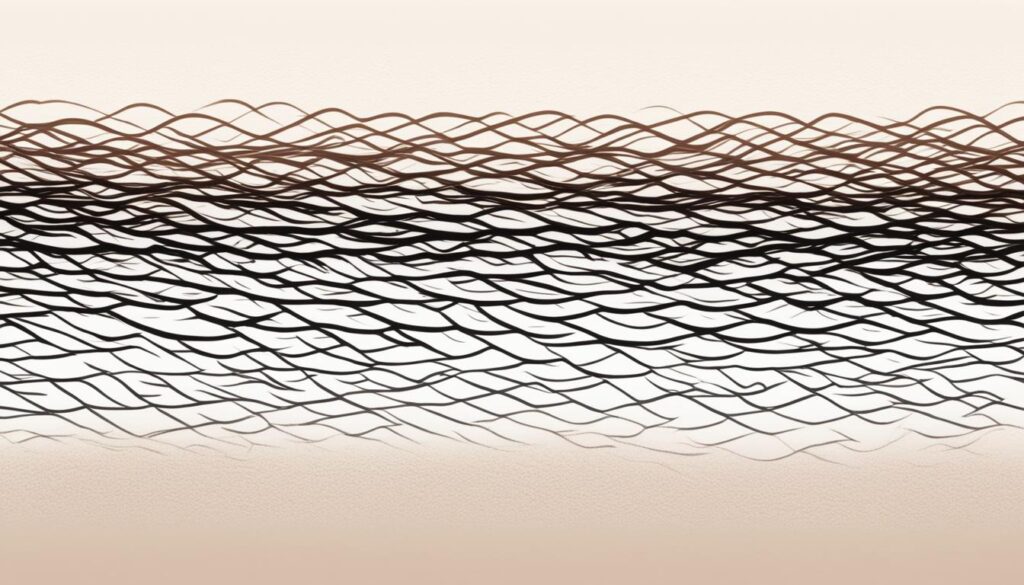Are you tired of constantly shaving or waxing to remove unwanted body hair? Laser hair removal can provide a long-lasting solution, but timing is everything. Is there an ideal season or period for laser hair removal? When is the best time to schedule your treatment for optimal results and minimal risk? Let’s dive into the factors that determine the perfect timing for laser hair removal.
Key Takeaways:
- The best time for laser hair removal is during the fall, winter, and spring months with lower sun exposure.
- Multiple treatments are usually required for optimal results, and the duration of hair removal can vary.
- Consulting with a practitioner is essential to determine the appropriate procedure and discuss any skin sensitivities or medication.
- Laser hair removal offers permanent hair reduction and smooth, hair-free skin.
- While the best time may vary, it is possible to receive laser hair removal year-round, depending on individual circumstances.
What is Laser Hair Removal?
Laser hair removal is a professional service that utilizes a laser to remove unwanted body hair. The laser beam creates heat energy that is absorbed by the pigment in the hair follicles, affecting the process responsible for hair production. This delay in hair growth can result in long-term hair reduction. Laser hair removal is suitable for people with different skin tones and can be performed on various areas of the body. Multiple treatments are usually required initially, and maintenance appointments can be scheduled to maintain the results.
How Long Does Laser Hair Removal Last?
Laser hair removal is considered a permanent method of hair reduction, but it does not completely stop hair growth. The duration of the results can vary depending on the individual and the area of the body being treated.
On average, laser hair removal can last up to 2 years before touch-up appointments are required. However, it’s important to note that several factors can influence the duration of the results:
- Hair type: The thickness and color of your hair can affect how long the results last. People with darker, coarser hair tend to see longer-lasting results compared to those with lighter, finer hair.
- Age: As we age, our hormone levels change, which can impact hair growth. Younger individuals may need more touch-up appointments compared to older individuals.
- Medication: Certain medications can stimulate hair growth, potentially reducing the efficacy of laser hair removal. It’s crucial to discuss any medication you’re taking with your practitioner before starting treatment.
- Hormones: Hormonal imbalances, such as those caused by pregnancy or menopause, can affect hair growth and the permanence of laser hair removal.
- Genetics: Each person’s body is unique, and genetics play a role in determining how long the results of laser hair removal last. Some individuals may experience longer-lasting results, while others may require more frequent touch-up appointments.
Before undergoing laser hair removal, it’s essential to consult with a practitioner to discuss your specific situation and understand the expected timeline for the treatment.
Timeline of Laser Hair Removal Results
The timeline of laser hair removal results can vary from person to person. While some individuals may experience long-lasting hair reduction after a few sessions, others may need more treatments to achieve their desired results. Here is a general timeline that you can expect:
| Session Number | Results |
|---|---|
| 1-3 | Reduction in hair growth, but may still need to shave or engage in other temporary hair removal methods |
| 4-6 | Significant reduction in hair growth, longer periods of smooth and hair-free skin |
| 7 or more | Lasting hair reduction, may require occasional touch-up appointments |
It’s important to note that these are general guidelines, and the exact number of sessions required and the timeline of results may vary depending on individual factors.

Is There a Best Time to Start a Laser Hair Removal Course?
Before embarking on a laser hair removal course, it is crucial to consult with a practitioner to ensure the appropriate procedure and address any concerns or medication that may impact the treatment. Determining the ideal time to begin your laser hair removal course is essential for optimal results. The fall, winter, and spring months are recommended for starting the course due to lower sun exposure. Laser hair removal can temporarily increase skin sensitivity to the sun’s rays, making it imperative to protect the skin from UV damage.
Starting your laser hair removal course during these seasons allows for ample time to complete the treatment cycle before the arrival of summer, when sun exposure becomes more frequent. It is advisable to avoid direct sun exposure for at least a month after the final treatment to prevent potential skin damage or discoloration.
Why is Winter the Best Time for Laser Hair Removal?
Winter is considered the best time for laser hair removal due to several advantages it offers. Firstly, the lower sun exposure during winter makes it an ideal treatment option as the skin is less likely to be exposed to harmful UV rays. This reduces the risk of potential complications and ensures a safer procedure.
Another benefit of winter laser hair removal is that people tend to have paler skin during the colder months. Paler skin tones require fewer laser treatments compared to those with tanned or darker skin. This means that individuals with paler skin can achieve their desired results in a shorter period of time, allowing for more efficient and cost-effective treatment.
Winter also provides a great opportunity to complete the laser hair removal process before the onset of summer. As the warmer months approach, skin exposure to the sun becomes more frequent. By undergoing laser hair removal during winter, you can ensure that your skin is hair-free and ready for the summer season.
Overall, the benefits of winter laser hair removal, such as lower sun exposure, a higher efficacy on paler skin, and the ability to complete the treatment before summer, make it an advantageous option for those seeking smooth and hair-free skin.

Winter Laser Hair Removal Advantages
| Advantages | Explanation |
|---|---|
| Lower sun exposure | Reduced risk of complications and UV damage |
| Paler skin | Requires fewer laser treatments for optimal results |
| Completion before summer | Prepares the skin for the summer season with hair-free results |
Benefits of Fall and Winter Laser Hair Removal
Laser hair removal is a highly effective method of achieving long-term hair reduction. Fall and winter are particularly advantageous seasons for undergoing laser hair removal due to a variety of reasons:
No sun exposure: One of the key advantages of fall and winter laser hair removal is the reduced risk of sunburn and skin damage. With less sun exposure during these seasons, the skin is less likely to be affected by UV rays, allowing for better healing after the treatment.
Less sweating: Fall and winter are typically cooler seasons, resulting in less sweating compared to the warmer months. This reduction in sweating can minimize discomfort during and after the laser hair removal treatment and reduce the risk of side effects.
No shaving or waxing required: To ensure optimal results, it is recommended to have at least four weeks of hair growth before laser hair removal. Fortunately, fall and winter provide the perfect opportunity to avoid shaving or waxing as we tend to cover up more during these seasons.
Ski clothing can hide treated areas: Another advantage of fall and winter laser hair removal is that the colder weather allows for the use of ski clothing, which can conveniently cover the treated areas. This provides added convenience and comfort while undergoing the treatment.
By taking advantage of the unique benefits offered during the fall and winter seasons, individuals can experience the full advantages of laser hair removal with reduced risks and enhanced comfort.
Comparing Fall and Winter Laser Hair Removal with Other Seasons
| Advantages | Fall/Winter | Spring/Summer | All Seasons |
|---|---|---|---|
| No sun exposure | ✓ | ✗ | ✗ |
| Less sweating | ✓ | ✗ | ✗ |
| No shaving or waxing required | ✓ | ✗ | ✗ |
| Ski clothing can hide treated areas | ✓ | ✗ | ✗ |
Advantages of Spring and Summer Laser Hair Removal
When it comes to laser hair removal, the general recommendation is to schedule your treatments during the fall and winter months. However, there are distinct advantages to getting the treatment done during spring and summer. Let’s explore the benefits of opting for laser hair removal during these warmer seasons.
Less Pain
During spring and summer, the skin is naturally more sensitive to heat. As a result, laser hair removal treatments tend to be less painful during these seasons compared to colder months. So if you’re someone who is concerned about discomfort, spring and summer could be the perfect time to undergo laser hair removal.
Faster Results
The hair follicles are more responsive to the laser during spring and summer, which means you’re likely to see faster results. The increased sensitivity of the hair follicles allows the laser to target them more effectively, resulting in quicker reduction of hair growth. This means you can achieve your desired results in a shorter period of time.
Fewer Side Effects
While laser hair removal can have side effects regardless of the season, they are generally less common during spring and summer. The combination of increased sun exposure and heat sensitivity during these seasons can help minimize potential side effects such as redness, swelling, and skin irritation. However, it is still important to take proper care of your skin and follow post-treatment instructions provided by your practitioner.
Better Tanning
For those who love a sun-kissed look, spring and summer laser hair removal can be advantageous. By having your hair removed before the sunnier months, your skin will be smoother and hair-free, allowing for better and more even tanning. You can confidently show off your beautifully bronzed skin without worrying about unwanted hair.
Overall, while fall and winter are traditionally recommended as the best time for laser hair removal, spring and summer come with their own set of advantages. With less pain, faster results, fewer side effects, and improved tanning, these seasons can provide an ideal opportunity to undergo laser hair removal and achieve smooth, hair-free skin.
Year-Round Laser Hair Removal
Laser hair removal can provide the benefits of permanent hair reduction and smooth, hair-free skin all year round. Whether it’s during the sunny summer months or the chilly winter season, laser hair removal remains an effective solution for removing unwanted hair from various parts of the body.
Unlike temporary hair removal methods like shaving or waxing, laser hair removal targets the hair follicles to achieve long-lasting results. The laser emits a concentrated beam of light that is absorbed by the pigment in the hair, damaging the follicle and inhibiting future hair growth. This process leads to permanent hair reduction, providing a hassle-free solution for smooth and hair-free skin.
Regardless of the season, laser hair removal can be performed on different areas of the body, such as the face, legs, underarms, or bikini area. The treatment is tailored to each individual’s needs and desired results, ensuring optimal outcomes.
Consulting with a skilled practitioner is essential to determine the best treatment plan for your specific needs. They will assess your skin type, hair growth pattern, and any potential contraindications to ensure the treatment is safe and effective.
Overall, laser hair removal offers a convenient and long-lasting solution for smoother, hair-free skin. Whether you’re looking to achieve a hair-free look for an upcoming vacation or simply desire the freedom from daily shaving or waxing, laser hair removal can provide the results you’re seeking. Consult with a trusted practitioner to explore the possibilities and embark on your journey towards permanent hair reduction.
Conclusion
In conclusion, the optimal timing for laser hair removal is during the fall, winter, or spring months. These seasons provide lower sun exposure, which reduces the risk of complications during the treatment.
However, it’s important to note that laser hair removal can be performed year-round, offering the benefits of permanent hair reduction and smooth, hair-free skin. Consultation with a practitioner is crucial to determine the best timing for the treatment based on individual factors such as skin type, hair growth, and desired results.
With the right timing and treatment plan, laser hair removal can provide long-lasting results and a hassle-free solution to unwanted body hair. Whether it’s for facial hair, legs, or any other area, laser hair removal can be an effective and convenient option for achieving your desired hair removal goals.
FAQ
When is the best time to get laser hair removal?
The best time to consider getting laser hair removal is during the fall, winter, and spring months when sun exposure is lower and the risk of complications is reduced.
What is Laser Hair Removal?
Laser hair removal is a professional service that utilizes a laser to remove unwanted body hair. The laser beam creates heat energy that is absorbed by the pigment in the hair follicles, affecting the process responsible for hair production, leading to long-term hair reduction.
How long does laser hair removal last?
Laser hair removal is considered a permanent method of hair reduction, but it does not completely stop hair growth. On average, the results can last up to 2 years before touch-up appointments are required. However, individual factors such as hair type, age, medication, hormones, and genetics can influence the duration of the results.
Is there a best time to start a laser hair removal course?
The ideal time to start a laser hair removal course is during the fall, winter, or spring months when the sun exposure is lower. It is important to consult with a practitioner to determine the appropriate procedure and discuss any concerns or medication that may affect the treatment.
Why is winter the best time for laser hair removal?
Winter is considered the best time for laser hair removal for several reasons. Firstly, the lower sun exposure during winter allows for a safer treatment as the skin is less likely to be exposed to harmful UV rays. Additionally, people with paler skin, which is common during the winter months, require fewer laser treatments compared to those with tanned or darker skin.
What are the benefits of fall and winter laser hair removal?
Fall and winter are considered the best seasons for laser hair removal as there is less sun exposure, reduced sweating, and an opportunity to avoid shaving or waxing. The colder weather also allows for the use of ski clothing to cover the treated areas, providing added convenience and comfort.
What are the advantages of spring and summer laser hair removal?
Despite the general recommendation for laser hair removal during fall and winter, there are advantages to getting the treatment done during spring and summer. During these seasons, the skin is typically more sensitive to heat, resulting in less pain during the treatment. Additionally, the hair follicles tend to be more responsive to the laser, leading to faster results. Side effects are also less common during spring and summer. Many people find that their skin tans better after laser hair removal during these seasons, enhancing the overall appearance.
Can laser hair removal be performed year-round?
Yes, laser hair removal can be performed year-round, offering the benefits of permanent hair reduction and smooth, hair-free skin. It is important to consult with a practitioner to determine the best treatment plan and ensure optimal results.
What is the optimal timing for laser hair removal?
The optimal timing for laser hair removal depends on individual factors such as skin type, hair growth, and desired results. It is recommended to consult with a practitioner to determine the ideal timing for the treatment.


